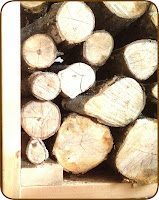
The woodshed is beginning to look a little empty.
Even though we are half way through the winter it would be nice to see a few more rows of firewood.
After seven years of heating with wood you might think that I would have the supply under control.
Not so. As I improve my harvesting abilities, I marginalize the job to accommodate other projects.
So, I only ever seem to get 'just enough' wood in.
Someday I'll get ahead on the fuel wood.
Our woodlot is one of our greatest assets here. We may be at a disadvantage when it comes to preparing arable land, but we have a healthy hardwood forest to provide us with an endless list of renewable resources; the least of which is mere firewood.
For that I am very thankful.
If you go by the book, we have enough fuel wood, if properly managed, to supply the family's needs indefinitely. In fact, the last three years of wood has come from roughly two acres, an area that I intend to convert to field crops. It is an area of mature maples that have grown poorly and are diseased by a fungus that consumes the heartwood leaving open wounds. These trees live, yet are easily susceptible to high winds which break the crown of the tree off.
Maple is my wood of choice for fuel. However, we have others to choose from. Among them each has it's own attributes with various purposes. There are a great many mature large-toothed aspens that supply me with general purpose lumber. There is spruce and balsam fir for softwood lumber. There is both white and black ash for specialty flooring and furniture. Although fewer in number, there is yellow birch and black cherry that I plan to use for woodworking. The beeches are, for the most part, past maturity and are gradually falling down from their weighty age. I love the look of their giant elephant legs and so I leave them alone to die peacefully.
 |
| Chainsaw Milling |
The woodlot also provides an abundance of plants on the forest floor that can be so robust during late Spring. The dense foliage and extreme humidity could easily convince you that you are in a rainforest. Among these plants are wild edibles and healing herbs. The first green of Spring draws us into the woods with buckets and trowels to selectively harvest a bounty of wild leeks. For you in the U.S., I am talking about ramps. Technically, it's wild garlic. Kira chooses plants from the woodlot for our gardens around the house. There are many striking shapes and flowers that are naturally hardy and visually pleasing. And of course, as it is for many of you, a walk in the forest alone or with family can heal the soul with it's meditative calm and grace. The souls of countless plants and animals filling the world with nothing less than life itself.

It is with a great deal of consideration that we change this landscape with our activities. We will not, for example, allow domestic livestock to forage the woods uncontrollably. There are areas that I intend to develop for agriculture, but only as carefully selected patches.
A critical component of our homesteading model is to find our niche in the environment; not superimpose ourselves upon it. Our resources must remain renewable if we are to achieve a sustainable state of farming.

I love working with the woodlot.
I love working in the woodlot.
Firewood duty doesn't become relegated because it's tedious. It just gets bumped down the list.
As I look at the dwindling pile I tell myself that this will be the year that I get ahead on the wood.
But I think I've said that for a few years in a row.






I was just thinking about wood this morning reflecting on the diminishing size of the woodpile outside....
ReplyDeleteFor those of us who live rurally the wood is a beautiful dilemma.
Watch it grow and dont cut it and you get cold and eventually you will be overrun by sucker growth. Commit to cutting and there are always poorer quality trees that need to come down and be burned first before you can get to the preferred wood you would rather. I am always torn to have to cut a tree and not use it. I have a managed forest and need to burn wood too. Given the choice I would spend all my time cutting trails. Trails for the dogs to run, trails for friends to walk and trails for the spirit to roam.....
Nice blog!
Martin
flashlightsandarrows@blogspot.com
(a near neighbour!)
Thanks Martin!
ReplyDeleteWe considered the managed forest option but decided against it. I like the free choice. I am learning good management through experience. One thing that I understand now is that there is no waste in the woodlot. I feel better about dropping a tree and letting it lie rather than using it. There are a lot of little mouths to feed out there and a tree on the ground does a lot of feeding. We have also learned to leave the standing dead trees. The previous owners took most of it to keep from having to cut live trees. Unfortunately, when you burn standing dead trees you are burning lots of homes. I clear-cut now. It's a bad word in some circles but it works much like a forest fire. It restarts the natural cycle and creates transition zones. It also limits the overall damage caused by wood harvesting in general by limiting the size of the work area.
Someday, I'd like to hunt in the woodlot again. Maybe you could teach me how to hunt for time!
Hunt to live.....live to hunt
ReplyDeleteMartin
flashlightsandarrows@blogspot.com